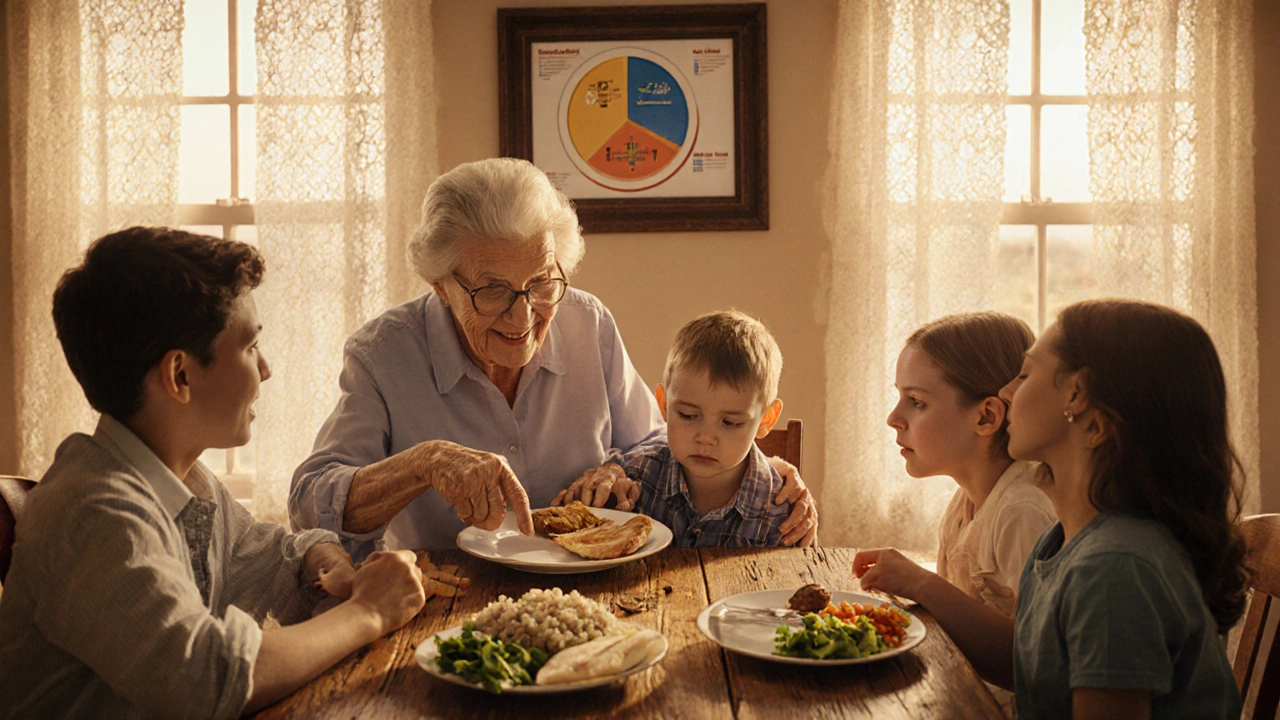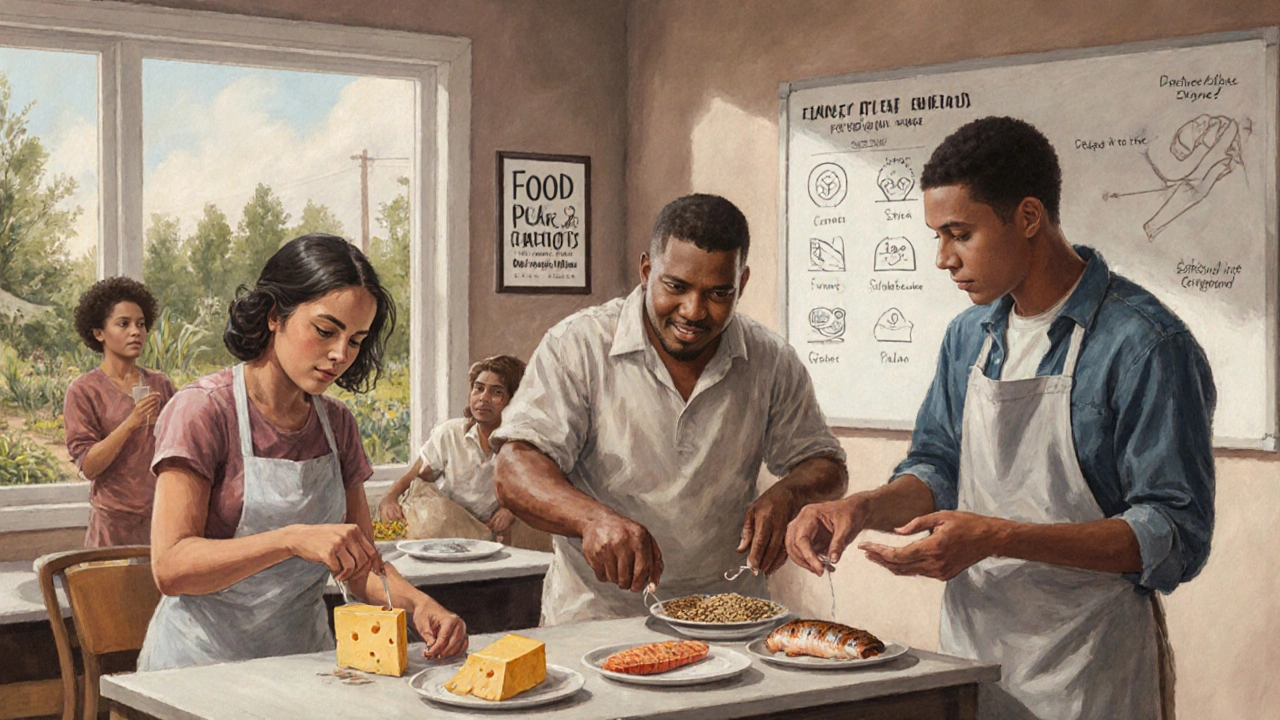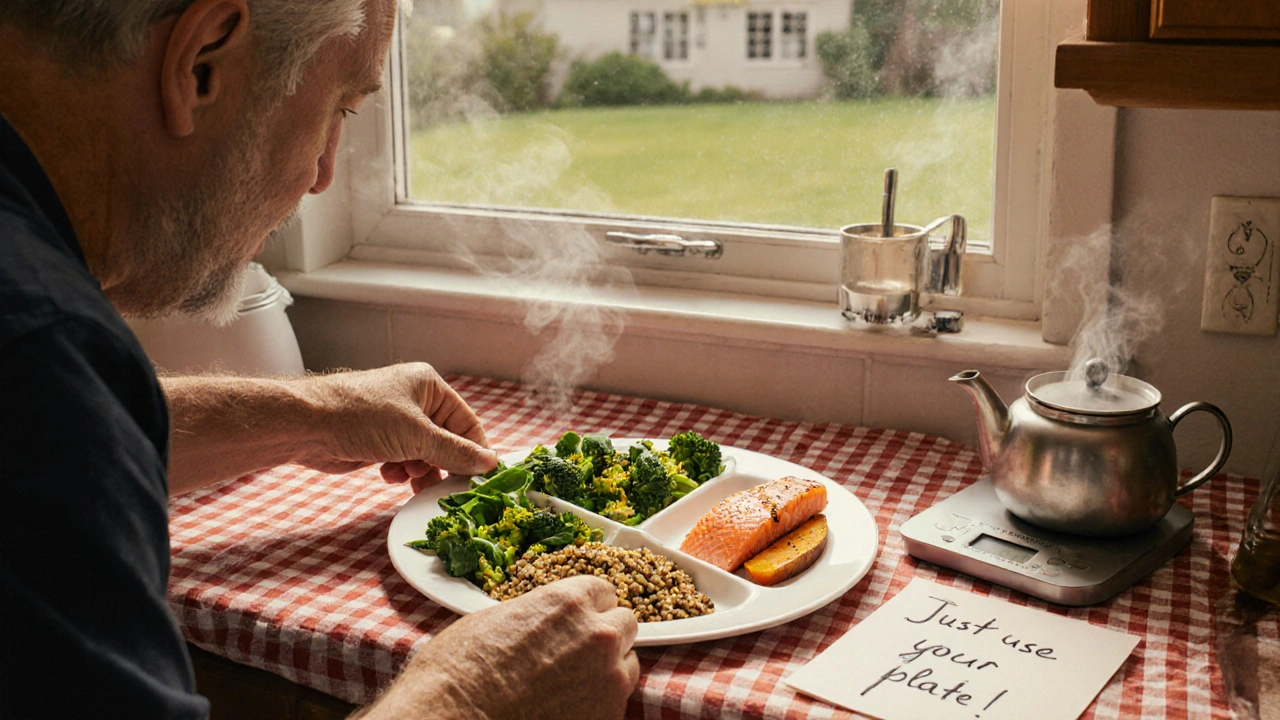Why Diabetic Meal Planning Matters
Managing diabetes isn’t just about taking medication-it’s about what’s on your plate. Eating the right foods at the right times helps keep your blood sugar steady, reduces the risk of nerve damage, heart disease, and kidney problems, and gives you more energy throughout the day. The American Diabetes Association (ADA) says the simplest and most effective way to do this is with the Diabetes Plate Method. No counting calories. No measuring portions with scales. Just use a 9-inch plate and divide it the right way.
Studies show that people who stick to structured meal plans for six months or longer see their HbA1c levels drop by 0.3% to 2.0%. That’s the difference between needing more medication and possibly reversing prediabetes. It’s not magic. It’s math. And it starts with what you put on your plate.
What to Put on Your Plate: The Simple 3-Part Rule
Here’s how the Diabetes Plate Method works in real life:
- Half the plate: Non-starchy vegetables. These are low in carbs and high in fiber, so they fill you up without spiking blood sugar. Think broccoli, spinach, kale, zucchini, bell peppers, mushrooms, green beans, and cauliflower.
- One-quarter of the plate: Lean protein. This keeps you full and helps maintain muscle. Choose skinless chicken, turkey, fish (especially salmon, mackerel, or sardines), tofu, eggs, or beans.
- One-quarter of the plate: Healthy carbohydrates. These are your energy source-but they must be the right kind. Go for whole grains like quinoa, barley, or brown rice; starchy vegetables like sweet potatoes or corn; or a small piece of fruit like an apple or orange.
That’s it. No complicated math. No apps needed. Just look at your plate. If it looks like this, you’re on track.
What Foods to Eat Daily
Some foods are your allies. Make them staples.
- Non-starchy vegetables: Aim for 2.5 to 3 cups a day. They’re packed with nutrients and barely affect blood sugar. Roast them, steam them, or toss them in a salad.
- Fatty fish: Eat salmon, trout, or sardines at least twice a week. They’re rich in omega-3s, which protect your heart-a big concern for people with diabetes.
- Legumes: Beans, lentils, and chickpeas are high in fiber and protein. A half-cup serving has about 20 grams of carbs, but the fiber slows digestion, so your blood sugar rises slowly.
- Whole grains: Swap white bread and pasta for whole-wheat versions, oats, or farro. One slice of whole-wheat bread has about 15 grams of carbs-the same as one small apple. But the fiber makes all the difference.
- Healthy fats: Avocados, nuts, seeds, and olive oil help your body absorb nutrients and keep you full longer. A tablespoon of olive oil or a handful of almonds (about 14 halves) is enough.
- Low-fat dairy: Choose unsweetened Greek yogurt, skim milk, or cottage cheese. Watch out: some "non-fat" yogurts are loaded with sugar to make up for the missing fat.
What to Avoid or Limit
These foods cause blood sugar spikes and often come with extra calories and unhealthy fats.
- Refined grains: White bread, white rice, regular pasta, and pastries are stripped of fiber. They turn to sugar fast. One slice of white bread can raise blood sugar more than a candy bar.
- Sugary drinks: Soda, sweet tea, fruit juice, and energy drinks are liquid sugar. One 12-ounce can of soda has about 40 grams of sugar-that’s 10 teaspoons. Even "100% fruit juice" is concentrated sugar with no fiber.
- Processed meats: Bacon, sausage, deli ham, and hot dogs are high in sodium and preservatives. They’re linked to higher heart disease risk, which is already elevated in diabetes.
- Added sugars: Candy, cookies, cakes, ice cream, and sweetened cereals. Even "natural" sweeteners like honey or maple syrup act like sugar in your body. Use them sparingly, if at all.
- Full-fat dairy: Whole milk, cream, and full-fat cheese are high in saturated fat. Choose low-fat or fat-free versions instead.
- Fried foods: French fries, fried chicken, and onion rings are double trouble-high in carbs and unhealthy fats. Baking, grilling, or air-frying are better options.

Portion Control Without Measuring Cups
You don’t need kitchen scales. Use your hand.
- Protein (meat, fish, tofu): A palm-sized portion (without fingers) is about 3 ounces.
- Cheese: Your thumb (from tip to base) equals about 1 ounce.
- Fruit: A closed fist is about 1 cup-perfect for berries, melon, or chopped apple.
- Grains or starchy veggies: Also about a fist-sized portion per meal.
- Butter or oil: The tip of your thumb to the first joint is roughly 1 tablespoon.
These visual cues work whether you’re at home, at a restaurant, or eating on the go.
When You Eat Matters Too
It’s not just what you eat-it’s when. Eating at regular times helps your body predict when insulin is needed.
- Try to eat meals every 4 to 5 hours. Skipping meals can cause blood sugar to drop too low, then rebound too high when you finally eat.
- Give your body 2 to 3 hours between meals to let blood sugar settle.
- If you’re active or on insulin, snacks may be necessary. Choose a small apple with a tablespoon of peanut butter, or a handful of almonds.
- For children with Type 2 diabetes, three small meals and three snacks a day help support growth without spiking sugar.
Meal Ideas That Work
Here are real examples of balanced meals using the plate method:
- Breakfast: Scrambled eggs with spinach and mushrooms, one slice of whole-wheat toast, and half a grapefruit.
- Lunch: Grilled chicken salad with mixed greens, cherry tomatoes, cucumbers, and a vinaigrette made with olive oil and vinegar. Add ½ cup of quinoa for carbs.
- Dinner: Baked salmon, roasted broccoli and carrots, and ½ cup of sweet potato mash.
- Snack: Plain Greek yogurt with a sprinkle of chia seeds and a few blueberries.
The Diabetes Food Hub (run by the ADA) offers free recipes and lets you build custom meal plans online. You can drag and drop meals into a weekly schedule. It’s simple, practical, and updated for 2023.

Real-Life Challenges and How to Handle Them
Life isn’t perfect. Neither is meal planning.
- Eating out? Ask for a half-portion or split a meal. Swap fries for a side salad. Skip the bread basket. Order grilled instead of fried.
- Cultural foods? You don’t have to give up your traditions. Make adjustments: use brown rice instead of white, reduce oil in curries, add more vegetables to stews.
- Food insecurity? One in four adults with diabetes struggles to afford healthy food. Community food banks, SNAP benefits, and local nutrition programs can help. Talk to your doctor or diabetes educator-they know where to point you.
- Cravings? Don’t fight them. Manage them. Keep healthy snacks on hand. Sometimes a small piece of dark chocolate (70% cocoa or higher) satisfies the sweet tooth without a spike.
What’s New in 2025?
Diabetes care is getting smarter.
- Continuous glucose monitors (CGMs) now sync with apps that suggest meals based on your blood sugar trends.
- AI-powered meal planners are starting to appear in apps-analyzing your eating habits and giving real-time feedback.
- More doctors are prescribing "food as medicine," including free or discounted produce through partnerships with local farms.
The goal isn’t perfection. It’s consistency. Even small, steady improvements in your eating habits can lead to big changes in how you feel and how your body responds over time.
Final Thought: It’s a Lifestyle, Not a Diet
You’re not trying to "beat" diabetes. You’re learning to live well with it. The foods you choose now aren’t temporary fixes-they’re long-term tools. The plate method isn’t a fad. It’s backed by 20 years of research, updated every five years by top experts. It works because it’s simple, flexible, and sustainable.
Start with one meal today. Use your plate. Fill half with vegetables. Add lean protein. Pick a whole grain. That’s it. Do that consistently, and your blood sugar will thank you.
Can I still eat fruit if I have diabetes?
Yes, absolutely. Fruit is packed with fiber, vitamins, and antioxidants. The key is portion size and timing. One small apple, one cup of berries, or half a banana is fine at a meal or snack. Avoid fruit juice-it lacks fiber and spikes blood sugar fast. Fresh or frozen fruit is always better than canned in syrup.
Are artificial sweeteners safe for people with diabetes?
Most artificial sweeteners like stevia, sucralose, and aspartame don’t raise blood sugar. But they’re not magic. Some studies suggest they may still trigger cravings or affect gut bacteria over time. Use them sparingly. Better yet, train your taste buds to enjoy food without added sweetness. It takes a few weeks, but you’ll start noticing natural flavors more.
Do I need to count carbs?
Not if you use the plate method. It’s designed to balance carbs without counting. But if you’re on insulin or have trouble controlling your numbers, carb counting can be helpful. Talk to a certified diabetes care and education specialist (CDCES). They can help you decide what approach fits your life.
What if I’m vegetarian or vegan?
The plate method works great for plant-based diets. Swap meat for tofu, tempeh, lentils, chickpeas, or edamame. Make sure you get enough protein and vitamin B12 (through fortified foods or supplements). Focus on whole, unprocessed plant foods. Avoid vegan junk food like sugary cereals or fried tofu nuggets-they’re still carbs with no fiber.
Can I drink alcohol with diabetes?
Moderation is key. One drink per day for women, two for men. Stick to dry wine, light beer, or spirits mixed with soda water and lime. Avoid sugary mixers like tonic water or juice. Alcohol can lower blood sugar, especially if you’re on insulin or certain pills. Always eat when you drink, and check your blood sugar before bed.
How long does it take to see results from meal planning?
Some people notice better energy and fewer cravings within a week. Blood sugar numbers usually start improving in 2 to 4 weeks. HbA1c-a measure of average blood sugar over 3 months-can drop noticeably in 3 to 6 months with consistent habits. Patience and persistence matter more than speed.

Kaylee Crosby
November 25, 2025 AT 02:26Also, swap white rice for cauliflower rice. It's weird at first but your taste buds adjust. I even put it in my stir fry and my kids didn't notice.
Adesokan Ayodeji
November 26, 2025 AT 23:27Karen Ryan
November 27, 2025 AT 16:46Terry Bell
November 27, 2025 AT 21:19